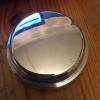
Oil Pressure
#1

Posted 12 May 2009 - 07:18 PM
Bit of an odd one, and to be frank, I'm getting brassed off with it now. After 10 years of working on minis, I thought I knew everything I needed to know, but this one has me stumped.
Right, bit of history - last year I decided to build a fresh lump, had the block honed and deglazed, new rings shells and bearings, and new oil pump fitted. I've not driven the engine yet, just running everything in.
Now for the present - No oil pressure! Well, on cranking over it builds some, and then it'll start up with a bit more, maybe 50psi on a good day. As the engine warms up, pressure drops. It usually gets as low as 7psi (according to the guage) but then i get a bit scared and kill the engine, god knows how low it will get if I didn't!
Heres what i've tried - Ajustable oil relief valve. Just the knob, the old bullet / ball and spring are still in there. The pump was primed prior to fit. I also backfilled the pump from the banjo bolt hole. Still no joy.
Should I be panicking? Will it fix itself when fully run in? How low can i safely go?
At this stage I'll welcome any advice I can get.
Thanks in advance,
Dan
#2

Posted 12 May 2009 - 07:25 PM
Replace with the ball bearing and adjustable spring and try that.
I got a new spring and ball from mini spares, cut 2 coils off the spring and then used the adjustable. 65psi whatever the engine was doing then. Lovely
Jordie
#3

Posted 12 May 2009 - 07:28 PM
1. Try another gauge and pipe from engine to gauge to make sure it isn't something really basic like this.
2. If you fitted new oil gallery plugs, check the ones you can see for leakage.
3. Then, if nothing makes any difference, take the engine out and strip it. Put in another new, high capacity oil pump. It may just be a duff oil pump. This has happened to me in the past and fitting a good quality pump cured the problem.
There is little point in risking getting a damaged engine when the symptoms do tend to point to an oil pump issue or, possibly, crankshaft to bearing clearances. It's interesting that you do get pressure initially, but that it drops off as the engine warms. I would, initially, be suspicious of the pipe to the gauge or, indeed, the gauge itself.
#4

Posted 12 May 2009 - 07:50 PM
I'll try removing the old spring and bullet to check for sticking. I forgot to do this when building the engine, and then when I remembered the lump was back in place, and I couldnt get the damn thing out. Any tips on removal? 65psi? For want and joy of 65! I'd be happy at 40!
Cooperman - I think you might actually be hitting the nail on the head with the guage suggestion. I'm getting oil flow to the rockers, which from experience tells me that's enough pressure, so it could well be something as silly as a kink in the braided pipe, or even a duff guage maybe.
I didn't replace the brass gallery plugs, as the old ones were pretty firmly in place with no signs of leakage. Over the years I've learnt to leave the old ones well alone if they are tip top. Currently no signs of external leakage at least, just the occasional drip from the timing cover.
The oil pump fitted is a minispares high capacity one, as you say it's strage how initially I have pressure which then dwindles to little, again, like you say, suggesting that the shell clearances are fine. This should be the case as it was a freshly ground crank with appropriate oversized shells and thrusts to suit.
Sooo... thus far, things i'll try this weekend are remove old relief valve, and inspect oil pressure guage and pipe.
Any other suggestions or advice on removing the relief valve with engine in situ are indeed beer token worthy.
Edited by Se7enS1ns, 12 May 2009 - 08:47 PM.
#5

Posted 12 May 2009 - 08:49 PM
#6

Posted 12 May 2009 - 09:04 PM
You should fit this higher rated one anyway as the stock one used to light the warning light at like 7lbs which was far too late anyway!
Edited by Stewart_GT, 12 May 2009 - 09:04 PM.
#7

Posted 12 May 2009 - 09:55 PM
If your gauge is electric then may be suspect, however if it's a Bernoulli tube (the bit inside that does moves the needle) if it where to fail you would either get a high reading or oil all over the place
Also with a kinked pipe, it would be low all the time....
Could be wrong size bearings for the crank, cam bearings not reamed correctly when fitted, knackered oil pump..... leaking gaskets or even missing seals
Also when you take out the plunger it is not a good idea to replace it with a ball, that is old school engineering and has been proven not to benefit the Mini, the plunger gives a more consistent flow rate
However the plungers can suffer with grit etc..... jamming them in place, as th eoil heats up the plunger valve would generally need to close and if it can't ........ well you get low pressure, incidentally dropping down to 7psi should not cause your engine any damage, unless it is really running rough and then it may do.
Regards Martin
#8

Posted 12 May 2009 - 10:06 PM
Also a large number of mini owners would disagree with you about the ball bearing and spring. It is widely regarded as a much better alternative to the plunger because of the jamming issues you mention.
Edited by Stewart_GT, 12 May 2009 - 10:06 PM.
#9

Posted 12 May 2009 - 10:16 PM
The guage is a mechanical Smiths item.
The crank was sourced as a recently ground item, not used since last grind. Can't remember off the top off my head what the journals were ground to, but I know i got the micromoeter on them to double check before buying shells and mains of the correct size, so I'm certain that my pressure woes are not being caused by excessive clearances. Cam bearings were reamed / hone suitably with new cam fitted. Pump is likewise, brand new. Could be suspect, but not worn out at least. No apparent leaking gaskets, not enough to justify such low pressure anyway. All seals present and located correctly.
Now the $64,000 question - How do I remove a stuck relief valve? If the valve is stuck open, would this account for gradually declining pressure? If so, can it be "persuaded" free by means of a suitable drift and a BFH?
Thanks for the suggestions, once again the combined logic beats my independant idiocy.
#10

Posted 13 May 2009 - 09:39 AM
Well all i can say is that my 22lbs sensor is spot on. Had oil pressure problems on my old engine as soon as the gauge dropped to 22lbs on came the red light on the dash.
Also a large number of mini owners would disagree with you about the ball bearing and spring. It is widely regarded as a much better alternative to the plunger because of the jamming issues you mention.
[QUOTE]
And of course your guage is also calibrated.......
A large number of Mini owners ? How many engine builders will agree though ? Ian at Avonbar never sold them because of the surge issues that they create, the only downside to the plunger is that they can sometimes stick.... this is normally down to a few things...
1) Incorrect or infrequent oil and filter changes
2) Not cleaning the engine block correctly whilst building a new engine
3) Not ensuring that whilst building the engine it is kept clean at all times
4) Not building a new engine in a clean environment
[QUOTE]
have no warning light at all, The wiring to the centre clock has been chopped over the years prior to my owneship, and I've not yet figured out how to wire the pressure switch in.
The guage is a mechanical Smiths item.
Cam bearings were reamed / hone suitably with new cam fitted. Pump is likewise, brand new. Could be suspect, but not worn out at least. No apparent leaking gaskets, not enough to justify such low pressure anyway. All seals present and located correctly.
How do I remove a stuck relief valve? If the valve is stuck open, would this account for gradually declining pressure? If so, can it be "persuaded" free by means of a suitable drift and a BFH?
[QUOTE]
Your warning lamp takes a live ign (hot when on feed) feed to the meter and then to the oil pressure sender...... 12v pos to meter, from meter to sender, sender goes to ground via the block.
Mechanical is the air out of the pipe, I doubt if this will cause it though..
Could you turn the camshaft freely by hand once it had been reamed ? and how was it reamed ?
Gasket leakage...... nor really a problem that you will see as I was referring to the gasket between pump and block... of course it is tight isn't it ?? as some of the newer pumps need shorter bolts, because the bolts bottom out
Removing a stuck pressure valve, can be done with a pair of thin and long circlip pliers or just long nose pliers... or a long bolt head has to be smaller than the hole in the plunger, a bit of rubber hose about 10mm long that fits in the plunger not too loose though, then a bit of tube to go over the bolt and do the nut up..... this compresses the rubber tube in to the plunger grab hold of the "tail" of the bolt and pull..
Regards Martin
#11

Posted 13 May 2009 - 09:33 PM
To answer your oil pump question, this fitted just fine with the new (pre encapsulated?) bolts supplied, the pump fits snuggly and the gasket remained seated throughout fitment, so I hope it's not the problem now!
I had another look at the adjustable relief valve this evening. When I wind the knob it, i can feel definite resistance, feels like the coils of the spring are binding / crushing, which suggests to me that the relief valve itself could possible be stuck open. the assembly is currently Adjustable knob>lockut>large block bolt>nut>washer>spring (if that makes sense to anybody). Is that correct?
Does the sping press directly onto the ball, or should there be something inbetween?
If the ball is stuck open, can I use a drift to close it?
Cheers again chaps!
#12

Posted 13 May 2009 - 10:22 PM
When it's stuck open with the oil hot it will read virtually zero at tickover, but come up somewhere near normal at over about 4500 rpm. I had this happen once with the plunger type and so long as I kept the revs over about 3500 it looked safe, but when the revs dropped it was quite worrying. However, I completed the rally I was in the middle of and, after sorting the problem back in the workshop, it had not damaged the engine at all despite my running a comp ratio of circa 11:1. Fit a new plunger type valve, but polish the plunger first with a good metal p;olish and using the tip of your little finger, make sure it slides in and out without resistance.
Peter
1 user(s) are reading this topic
0 members, 1 guests, 0 anonymous users

















